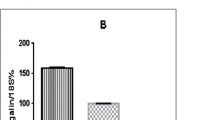Abstract
Objective
Placental transfer of Levofloxacin (LF), a broad spectrum fluoroquinolone antibiotic, and its inhibition was investigated in BeWo cells, a human trophoblast cell line.
Methods
The experiments of LF uptake by BeWo cells were performed after preincubation and in the presence of the P-glycoprotein inhibitors (Cyclosporin A, Verapamil and Quercetin), the organic anion/cation transporter inhibitor (Cimetidine) and the MCT substrates (lactic acid and salicylic acid).
Results
P-glycoprotein inhibitors increased the uptake of LF by BeWo cells. The increase in LF accumulation by Cyclosporin A, Verapamil and Quercetin was by 30, 90 and 80%, respectively. Cimetidine, the organic cation inhibitor, increased the transport of LF by 48%. Lactic acid and salicylic acid, the MCT substrates, initially decreased the accumulation of LF by 30% and subsequently increased the uptake of LF by 500 and 53%, respectively.
Conclusions
The uptake of LF by human trophoblast cells is mediated by multiple transporters as well as passive diffusion.




Similar content being viewed by others
References
Fish DN, Chow AT (1997) The clinical pharmacokinetics of levofloxacin. Clin Pharmacokinet 32:101–119
Mandel GL, Petri WA Jr (2006) The quinolones. In: Brunton LL, Lazo JS, Parker KL (eds) Goodman & Gilman’s the pharmacological basis of therapeutics, 11th edn. McGraw-Hill, New York, pp 1119–1126
Audus KL (1999) Controlling drug delivery across the placenta. Eur J Pharm Sci 8:161–165
Weier N, He SM, Li XT, Wang LL, Zhou SF (2008) Placental drug disposition and its clinical implications. Curr Drug Metab 9:106–121
Holcberg G, Tsadkin M, Sapir O, Huleihel M, Mazor M, Ben Zvi Z (2003) New aspects in placental drug transfer. Isr Med Assoc J 5(12):873–876
Chandorkar GA, Ampasavate C, Stobaugh JF, Audus KL (1999) Peptide transport and metabolism across the placenta. Adv Drug Deliv Rev 38:59–67
Myren M, Mose T, Mathiesen L, Knudsen LE (2007) The human placenta—an alternative for studying foetal exposure. Toxicol In Vitro 21:1332–1340
Polachek H, Holcberg G, Sapir G, Tsadkin M, Polachek J, Katz M, Ben Zvi Z (2005) Transfer of Ciprofloxacin, Ofloxacin and Levofloxacin across the perfused human placenta in vitro. Eur J Obstet Gynecol Reprod Biol 122:61–65
Pattilo RA, Gey GO, Delfs E, Mattingly RF (1968) Human hormone production in vitro. Science 159:1467–1469
Ringler GE, Strauss JF (1990) In vitro systems for the study of human placental endocrine function. Endocrinol Rev 11:105–123
Gips M, Barel S, Bridzy M, Soback S (1995) Detection of fluoroquinolone residues in milk. In: Proceedings of the third IDF international Mastitis seminar
Lowry OH, Rosebrough NJ, Farr AL, Randall RJ (1951) Protein measurement with the Folin phenol reagent. J Biol Chem 193:265–275
Young AM, Allen CE, Audus KL (2003) Efflux transporters of the human placenta. Adv Drug Deliv Rev 55:125–132
Nakamura Y, Ikeda S, Furukawa T, Sumizawa T, Tani A, Akiyama S, Nagata Y (1997) Function of P-glycoprotein expressed in placenta and mole. Biochem Biophys Res Commun 235:849–853
Gil S, Saura R, Forestier F, Farinotti R (2005) P-glycoprotein expression of the human placenta during pregnancy. Placenta 26:268–270
Lankas GR, Wise LD, Cartwright ME, Pippert T, Umbenhauer DR (1998) Placental P-glycoprotein deficiency enhances susceptibility to chemically induced birth defects in mice. Reprod Toxicol 12:457–463
Utoguchi N, Chandorkar GA, Avery M, Audus KL (2000) Functional expression of P-glycoprotein in primary cultures of human cytotrophoblast and BeWo cells. Reprod Toxicol 14:217–224
De Lange EC, Marchand S, Van Den Berg D, Van Der Sandt IC, De Boer AG, Delon A, Bouquet S, Couet W (2000) In vitro and in vivo investigations on fluoroquinolones; effects of the P-glycoprotein efflux transporter on brain distribution of sparfloxacin. Eur J Pharm Sci 12:85–93
Yamaguchi H, Yano I, Hashimoto Y, Inui KI (2000) Secretory mechanisms of grepafloxacin and levofloxacin in the human intestinal cell line Caco-2. J Pharmacol Exp Ther 295:360–366
Rabbaa L, Dautrey S, Colas-Linhart N (1996) Intestinal elimination of ofloxacin enantiomers in the rat: evidence of a carrier-mediated process. Antimicrob Agents Chemother 40:2126–2130
Ito T, Yano I, Tanaka K, Inuri KI (1997) Transport of quinolone antibacterial drugs by human P-glycoprotein expressed in a kidney epithelial cell line, LLC-PK1. J Pharmacol Exp Ther 282:955–960
Takaai M, Suzuki H, Ishida K, Tahara K, Hashimoto Y (2007) Pharmacokinetic analysis of transcellular transport of levofloxacin across LLC-PK1 and Caco-2 cell monolayers. Biol Pharm Bull 30(11):2167–2172
Hagenbuch B, Meier PJ (2004) Organic anion transporting polypeptides of the OATP/SLC21 family: phylogenetic classification as OATP/SLCO superfamily, new nomenclature and molecular/functional properties. Eur J Physiol 447:653–665
Cha SH, Sekine T, Fukushima JI, Kanai Y, Kobayashi Y, Goya T, Endou H (2001) Identification and characterization of human organic anion transporter 3 expressing predominantly in the kidney. Mol Pharmacol 59:1277–1286
Tahara H, Kusuhara H, Endou H, Koepsell H, Imaoka T, Fuse E, Sugiyama Y (2005) A species difference in the transport activities of H2 receptor antagonists by rat and human renal organic anion and cation transporters. J Pharmacol Exp Ther 15:337–345
Balkovetz DF, Leibach FH, Mahesh VB, Ganapathy V (1988) A proton gradient is the driving force for uphill transport of lactate in human placental brush-border membrane vesicles. J Biol Chem 263:13823–13830
Carstensen MH, Leichtweiss HP, Schroder H (1983) Lactate carriers in the artificially perfused human term placenta. Placenta 4:165–174
Utoguchi N, Magnusson M, Audus KL (1999) Carrier-mediated transport of monocarboxylic acid in BeWo cell monolayers as a model of the human trophoblast. J Pharma Sci 88:1288–1292
Ushigome F, Takanaga H, Matsuo H, Tsukimori K, Nakano H, Ohtani H, Sawada Y (2001) Uptake mechanism of valproic acid in human placental choriocarcinoma cell line (BeWo). Eur J Pharmacol 417:169–176
Alonso-Torre SR, Serrano MA, Alvarado F, Medina JM (1991) Carrier-mediated l-lactate transport in brush border membrane vesicles from rat placenta during late gestation. Biochem J 278:535–541
Conflict of interest statement
None.
Author information
Authors and Affiliations
Corresponding authors
Additional information
G. Holcberg and Z. Ben-Zvi contributed equally to this work.
Rights and permissions
About this article
Cite this article
Polachek, H., Holcberg, G., Polachek, J. et al. Carrier-mediated uptake of Levofloxacin by BeWo cells, a human trophoblast cell line. Arch Gynecol Obstet 281, 833–838 (2010). https://doi.org/10.1007/s00404-009-1177-y
Received:
Accepted:
Published:
Issue Date:
DOI: https://doi.org/10.1007/s00404-009-1177-y




